I arrived in Lisbon airport around 4 pm on Saturday Aug 11, which gave me an afternoon and evening on my own before Alinor and the kids arrived the next morning. After checking into my airport hotel and making sure the rental car was all set for the next day, I took the slow local bus to the Praça Marquess Pombal near the center of town. I love seeing new cities by public transportation. The bus took me through the empty-feeling outskirts of Lisbon, filled with graffiti and young people walking slowly down broad avenues through the heat. I had the feeling I wasn’t in England any more.
At the statue of the Marquess Pombal, the Prime Minister who rebuilt the city after the 1755 earthquake, producing the first urban grid in the Western world, I switched to the fast new Metro and zipped down to the banks of the Tagus. After buying a pair of sunglasses at a kiosk for 5 Euros, I walked uphill through the steep maze of the Alfama, past the Sé (cathedral) to the Castello San Jorge. I didn’t pay for entrance, but I looked from the castle walls over the city toward the Ponte de 25 April, which looks just like the Golden Gate. First of many visions of northern California on this trip.
Dinner that night in the Baixa, where the long avenue are closed to cars and filled with small tables for the cafes. Sitting down to a glass of vinho verde and a plate of fish-and-potato, I thought about how much fun it was to start by knowing nothing about Lisbon, just four hours earlier, and suddenly to have a sense of neighborhoods, public transit, the hills and wide river Tagus that dominates and orients the city. The last few days of the family trip we all stayed in Belem, about 6km west down the river, the port from which the great naus sailed to Africa, India, and Brazil, so we barely got back to the Baixa, and made only one trip to the Castello. Lisbon is a city to come back to.
After getting Alinor and the kids on Sun morning, we drove our Renault Clio (“the muse of history”) north on the A1, one of Portugal’s great highways, built recently, presumably with EU credit. After almost three hours north to Porto we picked up the coast road that leads north into the Minho region, then turned east up the Lima River valley to the exit for Calheiros, just a few km short of Ponte de Lima and its Roman bridge. Then the fun began: the drive to our villa in upper Calheiros was maybe 5 km from the highway exit, but we drove up and around and up some more. The roads were all paved, but they kept getting smaller and the stone houses and walls closer together. We followed signs – including a great sign for the village of “Portal” with an arrow pointing both ways, the door being always open in Portugal – and drove through one-lane stretches that felt as if they were sunk into small culverts between the ancient stone walls that terraced the hillside for farming.
When we got to the villa we found a traffic jam. Our host Diana was there, the owner of the villa was there, and then we pulled up behind both of them in a narrow alley surrounded by stone houses. The housekeeper had locked gate of the carport, and no one had the key. Portuguese was spoken, and the key was found.
The villa felt, and was, quite remote – the market to which we could walk was 1.5 km away, but along a paved road & besides it only featured old produce and Portuguese men drinking at all hours of the day or night. But the place itself was gorgeous. A small pool, a bit of flat lawn, an engineering feat on the steep hillside, a large deck, and a view across the Lima valley. The car port had table grapes growing in fat clusters, which we ate. The inside was Euro-new, complete with an electric stovetop that took us days to master, but the building also incorporated much older stonework in its construction.
3. The first few days were quiet as the kids and Alinor processed jet lag. We drove into Ponte de Lima for the big biweekly market on Monday, but it was huge and crowded and we didn’t stay. I found a supermarket & brought in enough food so that we didn’t have to eat all our meals down the hill. Slowly I mastered the mountain driving, and gradually figured out the lay of the land in and around Ponte de Lima. The story goes that Decimus Brutus’s legions at first refused to cross the river, thinking it was the Lethe & if they crossed they would forget their families and homes. So the commander crossed first and called his own name back to the men, after which they followed him north.
Monday night we met Sonja, a Portuguese women who drove up from Viana de Castello on the coast to cook arroz mariscos for us – a somewhat wetter version of paella with lots of mussels, calamari, pieces of fish, octopus, and huge prawns. We communicated with her mostly in French, which many people spoke more easily than English — it seems that during the depressed 70s a lot of residents of the Minho emigrated to France, and there are lots of connections that remain. We saw lots of EU cars with the letter “F” on the license plate, more than any other foreign country. That meal started a trend in Portuguese food: the seafood was great. We also liked the national pastry, pastel de nata, which are little custard tarts. The best ones are made in a mid-19c bakery in Belem right next to the hotel we stayed a when we were in Lisbon.
Tuesday it poured rain all day and we stayed in the villa, but Wednesday we drove over the mountains to Valença on the Spanish border to see the great fortress. Traffic was bad and the “shopping fortress” was filled with Spanish tourists snapping up Portuguese linens.
4. Thursday was the turning point of the trip: we drove up to Arcos de Valdevez to ride horses at Carlos Orlando’s Quinto do Fijo, which the villa’s office had suggested. Olivia got nervous about riding English saddles up steep mountain trails, but Alinor & Ian rode through the steep alleys and dirt paths, getting a local’s eye view of the network of roads and byways of the hills above Arcos. Olivia & I swam at the river beach on the Vez in town.
But the best of all was being put in touch with Carolos’s friend Luis Barros, who runs AktivaNatura, a kayaking/hiking/biking/etc outfit based in Ponte de Barca who became our guide for two of our remaining four days in the Minho. On Friday we met him near his office in Ponte de Barca & he drove us in his van into the Sierra Peneda, the northern valley of Portugal’s largest National Park. It’s a huge, high, stone-rimmed valley, almost entirely cut off on both sides until the Portuguese government put in a paved road in the 1970s. The driving is slow and sometimes frightening, with sheer drops, endless views, and free-ranging longhorn cattle and wild horses. We were only supposed to hike until around 7pm, according to the plans we’d made via Facebook with Luis, but he ended up giving us the full tour: a trip to the park entrance and its visitor center, to see the espagerras or stone granaries in Soajo, to a fantastic “fresh” (ie, cold) swimming hole just a bit past Soajo, and finally, after hours of driving & Olivia getting a bit carsick, as good a bit of hiking as I’ve ever done, over granite pathways and glacier-carved valleys, past live oaks and wild horses down to the town of Peneda, with its three-star hotel, famous church, and pilgrimage site. We made it to the hotel restaurant just before the kitchen closed at 9:30 pm. There we had local wine – vinho verde, but the red variety this time, which tasted a bit underaged, which is to say, like grape juice – veal steaks, and the only good chocolate mouse we found in Portugal.
Luis himself was as friendly and interested as you could wish. He runs Aktiva in part b/c of an ecological commitment to nature, as near as I can tell, partly inspired (I think) by his eco-themed reading of science fiction as a boy. We had a great conversation about E.E. “Doc” Smith’s Lensmen series after the sun went down and he was driving us back to Ponte de Barca through dark mountain roads. We made plans to go kayaking with him on Sunday. It was a festival night in Ponte de Barca when we go there, so all the cafes were still full at 12:30 am, but Olivia had been sleeping in the car for hours. A long day for her.
Saturday Luis had a big group of kayakers & we went to Braga, the largest city in the Minho and a religious center. Alinor & Olivia went to see an 18c Baroque palace, and Ian and I went to the amazing 16c Sé and the Roman baths. It was a fantastic cathedral, fill of many different styles of art and decoration. Ian lit a candle for Grandpa Charlie & talked eloquently about that strange feeling you get inside sacred places even if you’re not all that religious. Olivia bought cute sandals on the pedestrian avenues, where the two groups at lunch at separate cafes within a few hundred meters of each other. The salada de polvo (octopus) was the best thing any of us ate in Braga.
Sunday Olivia was feeling tired plus didn’t really want to kayak, so Ian & I went with Luis for 6 km of white water on the Vez. We met him in the Aquario, a café overlooking the river beach where Olivia & I had swam on Th. Luis pulled up in his trailer, we dropped his mini-motorbike – only 60 kilos! – so that he could drive back to get the boat trailer after we finished, he outfitted us both in lightweight shorty wetsuits, and away we went. The Vez was low, but not so low we couldn’t get through the 6 sets of rapids. Ian did great; he floated a little higher in the water than I did, so he could bounce off the rocks more easily. Luis also let him work things out for himself if he got a little bit stuck. It was great to see him figure out how to get his kayak pointed the right way in the white water.
I didn’t float quite as high as Ian – too many pasteles de nata? – and got dumped a couple of times. But the river was good for swimming too, and we all stopped at a rope swim on a calm section. Plus Luis gave us careful instruction in the right way to use a kayak paddle for maximum splashing.
We invited Luis to come back to our villa for dinner that night, and bought the best local vinho verde on his suggestions – Quito Mendalhes, I think was the name? We served a simple meal of pasta and tomato sauce, partly b/c we had not been shopping that day & also b/c that’s what Olivia liked eating. She was not as ready as I was for grilled sardines or fried baby mackerel, which really are the things to eat in Portugal.
Monday was meant to be our last full day in the villa, and we had a lovely slow morning around the pool. Alinor & I took a long walk up the road for about 45 minutes, but could not quite get to the rocky peaks above the village. After lunch, we were feeling restless, so we decided to go to Lisbon a day early. Fortunately our great hotel – Jeronimos 8 in Belem – could take us a day early, so off we went. Highway driving was easy, and though we arrived in Lisbon after dark, we navigated by the monastery and found our hotel without too much trouble. Not many people seem to live in Belem, though it’s flooded with tourists during the day, so street parking was easy.
Lisbon is a very different sort of place: full of people where the Minho was empty, crowded, with better food and more chaos. The next morning we snaked our way through the single-file turret up the Torre de Belem, saw the late 20c fascist monument to the Portuguese descobradores, and walked through the monastery, built with the wealth generated by the careirra de India. The highlight for me was the great maritime museum, one of the best I’ve ever seen.
It’s hard to believe the trip is over! I may have more to say about Pessoa and other matters. Plus for the dedicated who’ve read this far, here’s a link to our almost 400 photos.
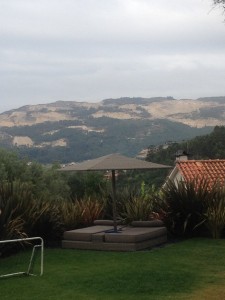
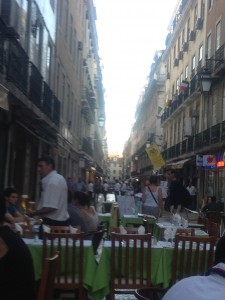
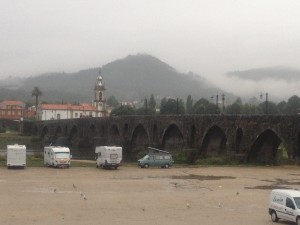
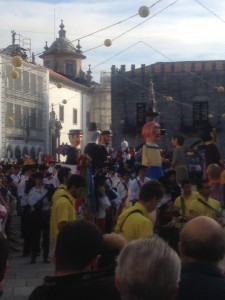
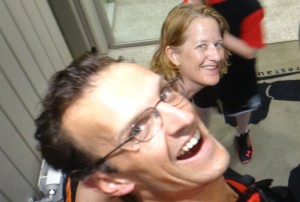
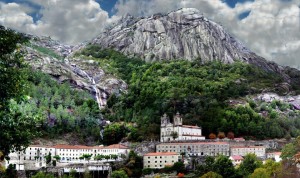
Great account of what sounds like a fantastic family trip. Love the line “we drove our Renault Clio (“the muse of history”) …”
We made a family visit to Lisbon three years ago and loved (but in the day we had didn’t do much more than the monastery, the tower, the fantastic maritime museum .